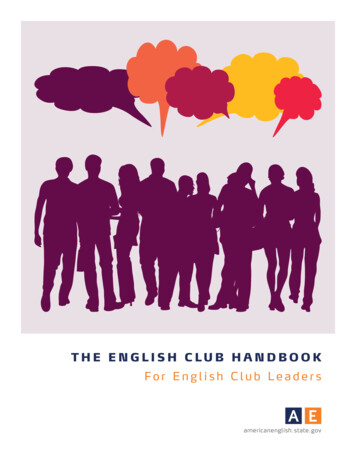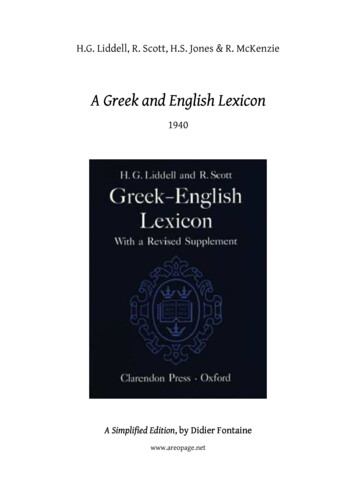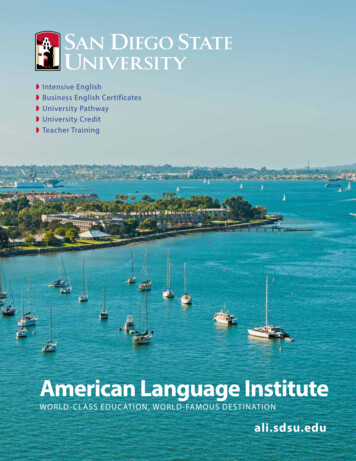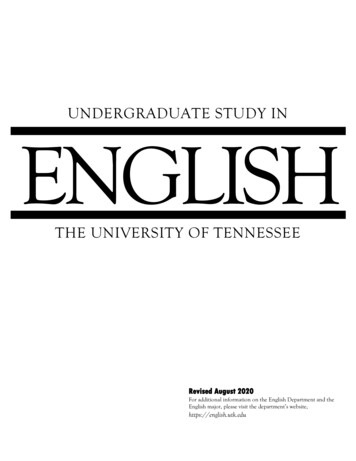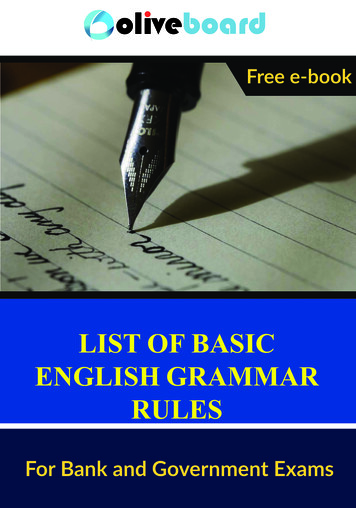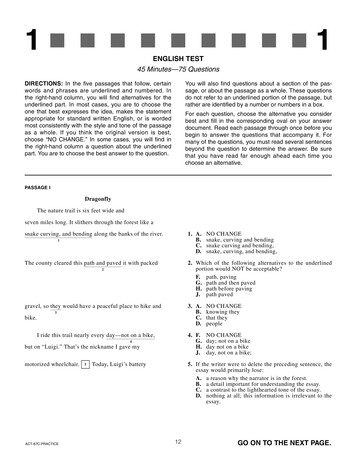
Transcription
11ENGLISH TEST45 Minutes—75 QuestionsDIRECTIONS: In the five passages that follow, certainwords and phrases are underlined and numbered. Inthe right-hand column, you will find alternatives for theunderlined part. In most cases, you are to choose theone that best expresses the idea, makes the statementappropriate for standard written English, or is wordedmost consistently with the style and tone of the passageas a whole. If you think the original version is best,choose “NO CHANGE.” In some cases, you will find inthe right-hand column a question about the underlinedpart. You are to choose the best answer to the question.You will also find questions about a section of the passage, or about the passage as a whole. These questionsdo not refer to an underlined portion of the passage, butrather are identified by a number or numbers in a box.For each question, choose the alternative you considerbest and fill in the corresponding oval on your answerdocument. Read each passage through once before youbegin to answer the questions that accompany it. Formany of the questions, you must read several sentencesbeyond the question to determine the answer. Be surethat you have read far enough ahead each time youchoose an alternative.PASSAGE IDragonflyThe nature trail is six feet wide andseven miles long. It slithers through the forest like a1. A.B.C.D.snake curving, and bending along the banks of the river.12. Which of the following alternatives to the underlinedportion would NOT be acceptable?F. path, pavingG. path and then pavedH. path before pavingJ. path pavedThe county cleared this path and paved it with packed2gravel, so they would have a peaceful place to hike andbike.3I ride this trail nearly every day—not on a bike,4but on “Luigi.” That’s the nickname I gave mymotorized wheelchair. % Today, Luigi’s batteryACT-67C-PRACTICENO CHANGEsnake, curving and bendingsnake curving and bending,snake, curving, and bending,3. A.B.C.D.NO CHANGEknowing theythat theypeople4. F.G.H.J.NO CHANGEday; not on a bikeday not on a bikeday, not on a bike;5. If the writer were to delete the preceding sentence, theessay would primarily lose:A. a reason why the narrator is in the forest.B. a detail important for understanding the essay.C. a contrast to the lighthearted tone of the essay.D. nothing at all; this information is irrelevant to theessay.12GO ON TO THE NEXT PAGE.
16. F.G.H.J.is fully charged, I know I can go all the way to the end6of the trail and back. But I always carry a cell phone onme just in case.7. Which choice would most logically and effectivelyemphasize the positive, friendly attitude the narratorhas toward Luigi?A. NO CHANGEB. travels safelyC. proceeds carefullyD. purrs softlyLuigi’s motor moves slowly as we venture along7the trail. I can hear the gravel quietly crunching beneathLuigi’s rubber wheels. I hear the songs of cardinals in the8trees and the clamor of crickets in the grasses. I hear themurmur of water slipping over time-smoothed rocks. It is9September, and some of the trees are starting to blush redand orange at their tips. The wind ruffles my hair and8. F.G.H.J.NO CHANGEYou can hearOne can even hearWhile hearing9. A.B.C.D.NO CHANGEDue to the fact that it isIt turns into the month ofBecause it has turned into10. F.G.H.J.chills my face as I bounce gently, along in my padded10chair.NO CHANGEcharged, because of that,charged, this means thatcharged, so1NO CHANGEgentle, alonggently alonggentle along,11. Which choice most effectively leads into the new subject of this paragraph?A. NO CHANGEB. The sun begins to setC. Nature always impresses meD. Days can go by quicklyBicyclists streak past in a blur of color and a cloud of11dust I don’t understand their hurry. Luigi can go fast, but I12like to ride slowly, to see like a hovering dragonfly. I wantto see everything that has changed, grown, bloomed, or12. F.G.H.J.NO CHANGEdust, however,dust.dust,13. A.B.C.D.NO CHANGEhour, looking,hour looking;hour lookingdied since yesterday. Today I notice that a spider haswoven a web between some honeysuckle bushes by thebridge. I see that the bank of vibrant yellow black-eyedSusans by the barbed wire fence is starting to dry and fadeaway. I spend an hour; looking and listening and learning.13ACT-67C-PRACTICE13GO ON TO THE NEXT PAGE.
11And now my ride is finished for today. I leave thetrail and come out into the open, manicured park at the14. F.G.H.J.trails end. There, my older brother helps me out of my14chair and into his waiting van. He puts Luigi in the back,and I return to the world of pavement, streetlights, andNO CHANGEtrail’strails’trails’sQuestion 15 asks about the preceding passageas a whole.traffic. But in my mind, I am still gliding through theforest. I am like the water, flowing over ancient stones.15. Suppose the writer’s goal had been to write an essayillustrating the pleasure that people can take in nature.Would this essay accomplish that goal?A. Yes, because it focuses on a variety of wildflowersthat the narrator enjoys.B. Yes, because it focuses on the narrator’s joy athaving access to nature.C. No, because it describes the world of the city asbeing more important to the narrator.D. No, because it focuses primarily on the functioning of the narrator’s motorized wheelchair.Inside, I am still a dragonfly.PASSAGE IIBeneath the Streets of New YorkAt 2 p.m., on October 27, 1904; thousands of16New York City residents poured into the streets ofManhattan. Their cheers competed with the blare of16. F.G.H.J.NO CHANGE2 p.m. on October 27, 1904, thousands2 p.m., on October 27, 1904; thousands,2 p.m. on October 27, 1904, thousands,17. A.B.C.D.NO CHANGEfeat, overfeat:featferryboat horns and the whistle of power plants. Thecity was celebrating an incredible engineering feat; the17completion of the first section of the New York CitySubway. 2ACT-67C-PRACTICE18. The writer is concerned about the level of detail in thepreceding sentence and is considering deleting thephrase “the first section of ” from it. If the writer wereto make this deletion, the paragraph would primarilylose information that:F. reveals how expansive the New York City Subwaywould become.G. clarifies that only part of the subway system hadbeen completed by October 27, 1904.H. makes clear that by October 27, 1904, constructionof the second section of the subway was alreadyunderway.J. provides evidence that New York City residents atthis celebration believed the entire subway systemwas complete.14GO ON TO THE NEXT PAGE.
11The original subway line was 9.1 miles long and hadtwenty-eight stations. [A] The first train took twenty-sixminutes to complete the route, which ran from City Hall19. A.B.C.D.to West 145th Street in under a half an hour. Tens of19thousands of New Yorkers could now avoid traffic jamsNO CHANGEin the completion of its route.in twenty-six minutes.DELETE the underlined portion and end the sentence with a period.20. Which choice would most effectively conclude thesentence by indicating clearly how the subway systemcould address the problem described in the first part ofthe sentence?F. NO CHANGEG. traveling more effectively.H. trying something new.J. using a system.by traveling underneath the streets. [B]20As early as 1865, there had been proposals for aNew York subway, but that took decades to resolve the21many political, financial, and technical challenges. Theengineer, William Barclay Parsons accepted responsibility22for overseeing this project.Parsons decided that most of the subway tunnelwould be constructed using an innovation engineering23method known as “cut and cover.” [C] First, workers used21. A.B.C.D.NO CHANGEitthoseDELETE the underlined portion.22. F.G.H.J.NO CHANGEengineer—William Barclay Parsonsengineer William Barclay Parsons,engineer William Barclay Parsons23. A.B.C.D.NO CHANGEinnovate engineerinnovative engineeringinnovate engineering24. F. NO CHANGEG. into the ground deeply under where the roads hadpreviously been removed by them.H. a trench far down below since it was necessary toshovel deep into the earth in this method known as“cut and cover.”J. DELETE the underlined portion and end the sentence with a period.picks and shovels to remove roads and dig a deep trench.24After installing wooden braces to hold back the earth,workers built a concrete floor. Tunnel walls were25. A.B.C.D.created: with layers of brick, ceramic blocks, tar-soaked25felt for waterproofing, and concrete. The roof was madefrom arch-shaped wooden molds also covered withNO CHANGEcreated, withcreated withcreated with:concrete. Next, track beds were filled with crushed stone,and rails were secured to wooden ties. Finally, the roof wascovered with tar-soaked felt, and the roads were rebuilt.ACT-67C-PRACTICE15GO ON TO THE NEXT PAGE.
11Brightly lit stations welcomed the public, manyof them were skeptical of traveling underground. [D] It26didn’t take long for New Yorkers to adapt, however. The27day after the subway opened, one newspaper reported thatthe riders were emerging from underground “having26. F.G.H.J.NO CHANGEof whomof whoDELETE the underlined portion.27. A.B.C.D.NO CHANGEtherefore.for instance.that is.finished what will be to them the daily routine of therest of their lives.” 28. The writer wishes to add a sentence that describes themagnitude and expansiveness of the New York CitySubway system today. Given that all the followingstatements are true, which one, if added here, wouldmost clearly and effectively accomplish the writer’sgoal?F. Even today, for many New Yorkers that news paper’s account is right!G. Today, riding a portion of the New York CitySubway’s 656 miles of mainline track is a dailyroutine for more than 4 million people.H. Today, the New York City Transit Authority continuously maintains two separate fleets of subwaycars.J. Now, a typical New York City Subway waitingplatform ranges from 400 to 700 feet.Question 29 asks about the preceding passageas a whole.29. Upon reviewing the essay and finding that some information has been left out, the writer composes the following sentence incorporating that information:This technique, also known as “open excavation,” became the standard for subway tunneling for nearly sixty years.If the writer were to add this sentence to the essay, thesentence would most logically be placed at Point:A. A.B. B.C. C.D. D.ACT-67C-PRACTICE16GO ON TO THE NEXT PAGE.
11PASSAGE IIIDiego Rivera: The People’s PainterIn the 1920s, Mexican artist Diego Rivera30. The writer wants to suggest that the art of the frescohad been in decline previous to Rivera. Which choicebest accomplishes that goal?F. NO CHANGEG. engaged inH. influencedJ. revived(1886–1957) practiced the art of painting frescoes, large30murals done on fresh plaster. Rivera’s frescoes appearedon the outside walls of buildings in Mexico City, in plainsight of any passerby. This brought art out of the elite31. A.B.C.D.galleries by catering to the upper class and literally to thepublic.31NO CHANGEthat cateredwhile cateringand catered32. F. NO CHANGEG. Rivera should wield more political power for hisbelief that controversy attracted the working class.H. Rivera for his controversy attracted belief that theworking class should wield more political power.J. Rivera attracted controversy for his belief that theworking class should wield more political power.Rivera attracted for his belief controversy that the32working class should wield more political power. His32dominant artistic subject in his art was as expansive33than his frescoes: the role played by laborers in the past,34present, and future of humanity. One of his frescoes depict35a progression through time and can be read as time linesfrom left to right. For example, on the left side of a fresco,33. A.B.C.D.NO CHANGEthat he was interested inthat he focused onDELETE the underlined portion.34. F.G.H.J.NO CHANGEthenasif35. A.B.C.D.NO CHANGEManyEachAny one36. F.G.H.J.NO CHANGEhistory; thehistory, thehistory—the37. A.B.C.D.NO CHANGEif it werewasif it wasthere might be field workers hunched over in fatigue andsurrounded by the tools of their trade. On the right side,after they have moved through history. The same workers36stand tall, radiating strength and confidence. Suchempowerment of the worker were to be the bright future37Rivera envisioned for all the workers of the world.ACT-67C-PRACTICE17GO ON TO THE NEXT PAGE.
138. F.G.H.J.Rivera received various prestigious commissions38while he was in the United States. In the 1930s, he wascommissioned by the Ford Motor Company to paintNO CHANGEvarious, prestigious,various, and prestigiousvarious and prestigious,139. If the underlined phrase were deleted, the sentencewould primarily lose a detail that:A. repeats information found elsewhere in thesentence.B. is necessary for the sentence to be grammaticallycomplete.C. provides new and relevant information to thesentence.D. is ambiguous and unnecessary to the sentence.a twenty-seven-panel fresco in the Detroit Institute of Arts.39The fresco, Detroit Industry, portrays some of the variedgroups that shaped American culture and constituted itsworkforce. The central panel on the north wall shows themanufacture of a 1932 Ford V-8 engine, when the central40panel on the south wall shows the production of this samecar’s exterior. Smaller panels depicting workers in a4140. F.G.H.J.NO CHANGEsincethusand41. A.B.C.D.NO CHANGEdepictdepicting somehad depictedvariety of other Detroit industries. J The fresco is a42. The writer is thinking of adding the following phraseto the end of the preceding sentence (changing theperiod after industries to a comma):such as medicine, pharmaceuticals, andchemicals.Should the writer make this addition there?F. Yes, because it offers relevant examples that helpto specify a broad term.G. Yes, because it helps explain how the panels werephysically constructed.H. No, because it provides a sampling of industriesrather than a full listing.J. No, because it digresses from the main point of thesentence.dynamic work because, by cap
ACT-67C-PRACTICE GO ON TO THE NEXT PAGE. 11 Question 29 asks about the preceding passage as a whole. 26 27 16



